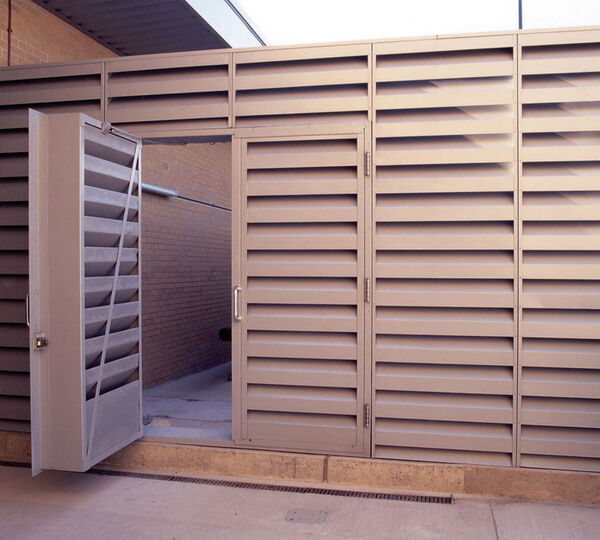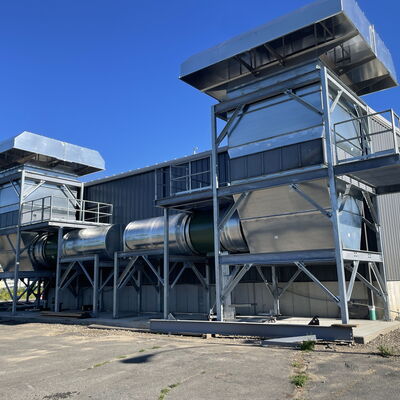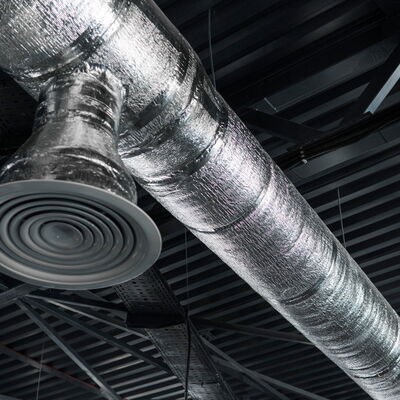Noise-Reducing Ventilation Solutions for Walls and Mechanical Systems
What Are Acoustic Louvers?
Acoustic louvers are specially engineered ventilation components that combine aerodynamic air passage with internal sound-absorbing treatments. While standard louvers are designed simply to allow airflow and block water or debris, acoustic louvers go a step further by incorporating acoustic baffles within each blade or channel. These internal baffles are typically filled with mineral wool or fiberglass and protected by perforated metal, enabling them to absorb noise as air moves through.
Available in a variety of blade depths and thicknesses, acoustic louvers can be customized based on airflow requirements and desired noise reduction levels. They are typically constructed from galvanized steel, aluminum, or stainless steel for long-term performance in both indoor and outdoor environments.
Key Differences from Standard Louvers
The primary distinction between standard and acoustic louvers lies in sound attenuation. Standard louvers are designed to provide air passage and protection from rain, but they do little to prevent sound from escaping or entering. Acoustic louvers, on the other hand, are engineered to absorb and reduce sound energy while still maintaining acceptable pressure drop and ventilation characteristics.
Where standard louvers may transmit significant noise from HVAC units, generators, or industrial machinery, acoustic louvers can provide up to 15–25 dB of sound reduction depending on configuration. This makes them a superior choice for projects that require both ventilation and noise control.
Where and How Acoustic Louvers Are Used
Acoustic louvers are typically installed in exterior walls, equipment screens, and mechanical enclosures where sound control and air exchange are both essential. Common applications include:
- HVAC Intake and Exhaust Openings: Reduce mechanical noise at building openings.
- Mechanical Equipment Enclosures: Provide airflow while containing sound from pumps, compressors, and generators.
- Acoustic Barrier Walls: Allow air passage without compromising the wall’s overall STC or sound transmission performance.
- Parking Garages: Control ventilation noise and improve environmental sound conditions.
- Data Centers and Industrial Facilities: Help manage cooling airflow while minimizing sound breakout.
Installation typically involves mounting louvers into wall frames, duct openings, or custom-fabricated plenum boxes. Louvers can be designed for horizontal or vertical mounting and are available with flanges, sleeve extensions, bird screens, or weather hoods as needed.
Benefits of Acoustic Louvers
- Airflow and Ventilation: Maintain necessary airflow for mechanical systems without sealing off openings.
- Noise Reduction: Reduce transmitted noise by 15–25 decibels or more depending on model and frequency.
- Durability: Built from weather-resistant materials for use in demanding environments.
- Custom Sizes and Configurations: Designed to match project-specific airflow, pressure drop, and acoustic goals.
- Low Maintenance: No moving parts and corrosion-resistant finishes make for easy, long-term operation

Related Products

HVAC Acoustic Silencers
One of the most effective ways to control noise generated by air handling systems is through the use of HVAC acoustic silencers. Also known as duct silencers or sound attenuators, these specially engineered devices are critical for achieving optimal indoor sound quality.

Acoustic Pipe and Duct Wrap
Mechanical systems such as HVAC ductwork, plumbing, and drainage pipes are essential for any building's function—but they can also be major sources of unwanted noise. Pipe and Duct Wrap is used to mitigate breakout and vibrational noise.
Frequently Asked Questions
A: Use acoustic louvers whenever you need to allow airflow into or out of a space but also want to limit the amount of noise passing through. They are ideal for mechanical rooms, HVAC penetrations, generator enclosures, acoustic enclosures, sound barrier walls, and any location where ventilation and sound control must coexist. Acoustic louvers are also useful in urban environments where environmental noise mitigation is critical, or in sensitive facilities such as hospitals, schools, or data centers where uninterrupted airflow must be balanced with quiet operation.
A: Diffusers are typically placed on the rear wall, ceiling, or upper side walls. In studios, rear wall placement enhances imaging and depth by scattering sound that would otherwise reflect directly back to the listening position. In larger halls or open rooms, ceiling and high wall diffusion can break up vertical flutter and standing waves that degrade clarity. Ceiling-mounted diffusers can also improve listener experience in venues with high ceilings by reducing echo and enhancing sound coverage across the room.
A: Yes. Our acoustic louvers are built for both interior and exterior use. They are made from galvanized steel or aluminum with durable, weather-resistant finishes that can withstand harsh outdoor environments, including wind, rain, and UV exposure. Optional rain hoods, bird screens, and storm-resistant accessories can be included for added protection, making them suitable for rooftops, exposed walls, and industrial facilities.
A: Absolutely. We offer a wide variety of sizes, blade depths, finishes, and mounting configurations to meet your project’s specific airflow and sound attenuation goals. Whether you need horizontal or vertical blades, recessed or flanged frames, or custom colors and coatings to match architectural elements, DDS Acoustical Specialties can help design the right solution. Specialty coatings for marine or corrosive environments are also available.
A: Louvers are typically installed into framed wall openings, duct systems, or mechanical screens using flange frames, recessed channels, or sleeve extensions. They may also be installed within acoustic wall assemblies or barrier systems. Proper sealing around the frame perimeter is essential to maintaining acoustic performance and preventing air leakage. Our team can provide mounting drawings, coordination with mechanical and architectural trades, and submittal data for proper integration into your project.
A: All louvers introduce some resistance to airflow, known as pressure drop. However, our acoustic louvers are engineered to achieve a careful balance between airflow capacity and acoustic attenuation. Detailed airflow performance data, including pressure drop charts and free area percentages, are available to ensure compatibility with your HVAC design. By selecting the correct blade configuration and depth, we help maintain efficient airflow while achieving your noise control goals.
A: Yes. Acoustic louvers are often used in conjunction with other sound control solutions such as absorptive barrier walls, silenced duct systems, vibration isolation mounts, and acoustic enclosures. In many cases, louvers are one part of a larger system designed to control both airborne and structure-borne noise. Integrating them into your acoustical design enhances system performance and ensures compliance with project noise criteria and local code requirements.


